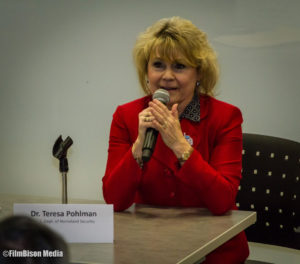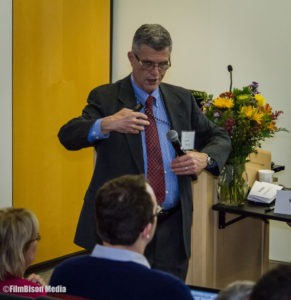
By BARBARA ENGLEHART, MATTHEW SHONMAN, and TRAVIS HIGH
Two sustainability leaders at the federal and municipal level participated in a Town Hall discussion at the 3rd Annual Energy and Sustainability Extravaganza on February 24, 2017 at The George Washington University in Washington, DC. The extravaganza featured a series of panels, including a CWEEL luncheon, presentations by university sustainability officers and by vendors with sustainable solutions, town hall discussion with government leaders, and networking reception.
Dr. Teresa Pohlman, Director of Occupational Safety and Environmental Programs at the Department of Homeland Security (DHS), and Loren Bruce, Senior Planner for the City of Falls Church, Virginia, participated in the Town Hall moderated by Robin Robinson.
Renewable Energy is Homeland Security

Dr. Pohlman has a mantra regarding the energy outlook. “Renewable energy must be part and parcel of energy security, and by extension, homeland security.”
A very real question confronting DHS infrastructure planners is what happens if the power grid fails. One of the department’s largest programs is the National Protection and Programs Directorate, responsible for American infrastructure security, including protection of the electric grid. Putting in place redundancies that include reliable renewable energy sources is a policy priority.
Describing her role as integrating the principles of sustainability and conservation within the work of DHS, Dr. Pohlman’s challenge is to ensure that sustainability projects enhance the DHS mission, rather than compete with it. What she has found is that there is a convergence between security and environmental policies, and that the department is very engaged. Customs and Border Protection agents have been at the forefront of addressing environmental issues at the border, such as hazardous waste.
Sustainability is also important for DHS vehicles. The department has a fleet of 50,000 vehicles, of which 10,000 use alternate fuel and 280 are hybrid electric. Power or electricity costs per year average $400 million, an outlay that the department is working to reduce in innovative ways. Interestingly, a study by the General Services Administration found that sustainable construction not only reduced costs, but also increased productivity at healthy facilities with good natural lighting.
Dreams and success stories

According to Bruce, embracing sustainability is “the greatest challenge facing humanity in the next 50 to 75 years,” and that it is time for planners to think of “impossible dreams” that bring win-win solutions to confront this challenge. Sustainability is about humanity’s vision for the future we want to live in.
In his view, local- and state-level action is critical to moving forward innovative projects. Currently, he is working on a particular challenge in Falls Church, VA that involves a piece of unprofitable land around a Metro station. There is a proposal to create a Center for Sustainable Research and Development that would combine a think tank and high school in one site, all while collaborating with commercial interests.
The city is currently working on building public support for the project, but if it moves forward, Bruce believes it would draw people from around the country. As it has been designed, it would make Falls Church the first city in Virginia with a net-zero high school, akin to Discovery Elementary School in Arlington.
Bruce stressed the importance of communicating the financial benefits of reducing energy use across the full life cycle of a building, vehicle, or other product. Securing the support of stakeholders can sometimes make or break a project, so for that reason Dr. Pohlman added that facility managers are key for buy-in. And although she acknowledged that the law sometimes requires compliance with certain environmental programs or policies, it also behooves any project manager to do the necessary business cases to convince the decision-makers that it is a smart business move, and to continually explore new opportunities.
Fortunately for Dr. Pohlman, not only is there strong management support for sustainability in DHS programs, but also the department has excelled at them. For example, FEMA won a GreenGov Presidential Award for incorporating sustainability and resiliency into the rebuilding of Long Island, NY, in the wake of Superstorm Sandy.
Dr. Pohlman also shared with the audience what has worked well for her agency in terms of sustainability management. Here are a few examples:
- Developing an integrated plan for stewardship of natural resources
- Using energy savings performance contracts
- Applying oversight, program management reviews and award programs
- Coordinating with other communities of practice – contracting, IT, finance, etc.
- Building a solid business case
- Working with state, tribal, territorial and local government as well as private-sector stakeholders to build grassroots support
Outlook for government involvement in sustainability projects
As the Town Hall concluded, one lingering question for the panelists was about the outlook for sustainability policy, whether at the federal, state, tribal, territorial and local level.
When asked what the Trump Administration will mean for environmental programs at an agency like DHS, Dr. Pohlman said that sustainability-linked executive orders and legislation remain in effect. With convincing business case analyses, and demonstration of return on investment, she is confident in the ability to convince officials of the value of her programs by showing demonstrable progress and cost savings over time.
At the local level, Bruce shared a vision of local hubs where business, government, and education work together, building circular economy models, and all benefit. He gave examples of communities that have been successful with this approach, such as Pittsburgh’s Cathedral of Learning and North Carolina’s research triangle of Durham, Raleigh, and Chapel Hill. He believes that a proposal like the one he presented for Falls Church would benefit both Metro and the municipal government. Those are the kind of win-win scenarios he envisions.
The event closed with an open question, which was how to engage students in sustainability work? Clearly, success stories can be found in different levels of government for those who hear the siren call of public service, but students needn’t look too far. Their own college campuses have become laboratories for sustainability projects.
Our next article in this series will delve deeper into some of these examples.
Photos courtesy of Film Bison Media.


Leave a Reply